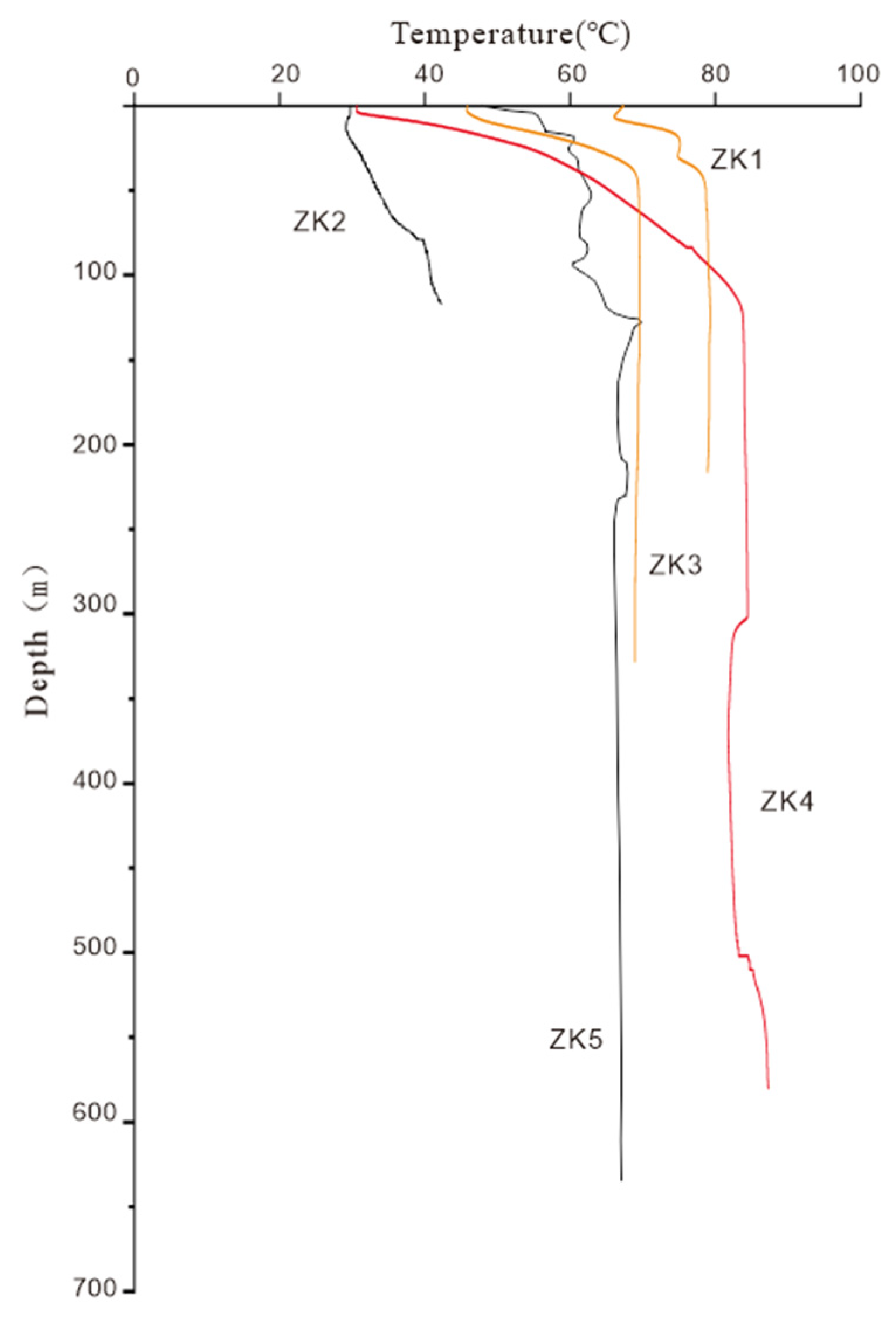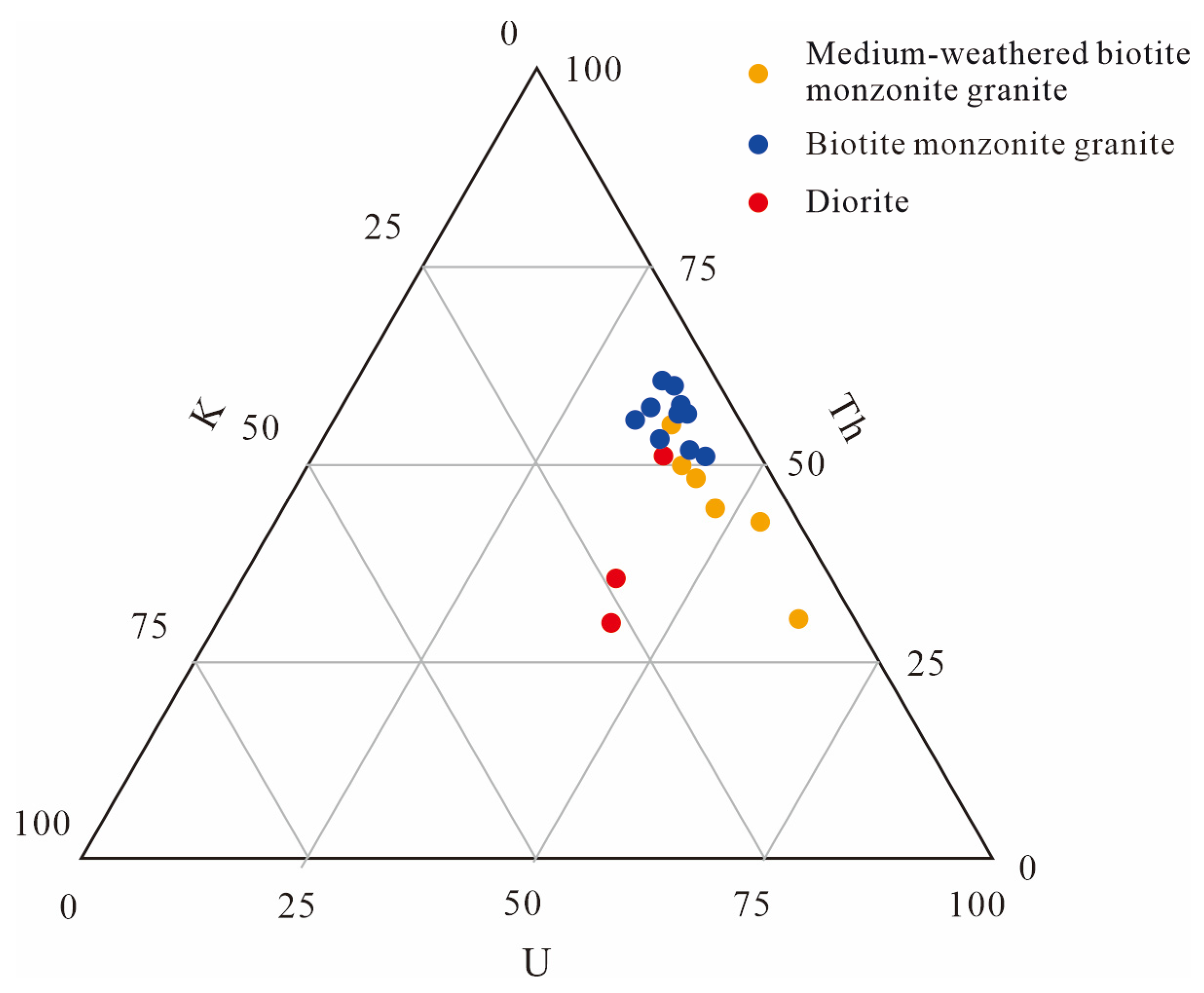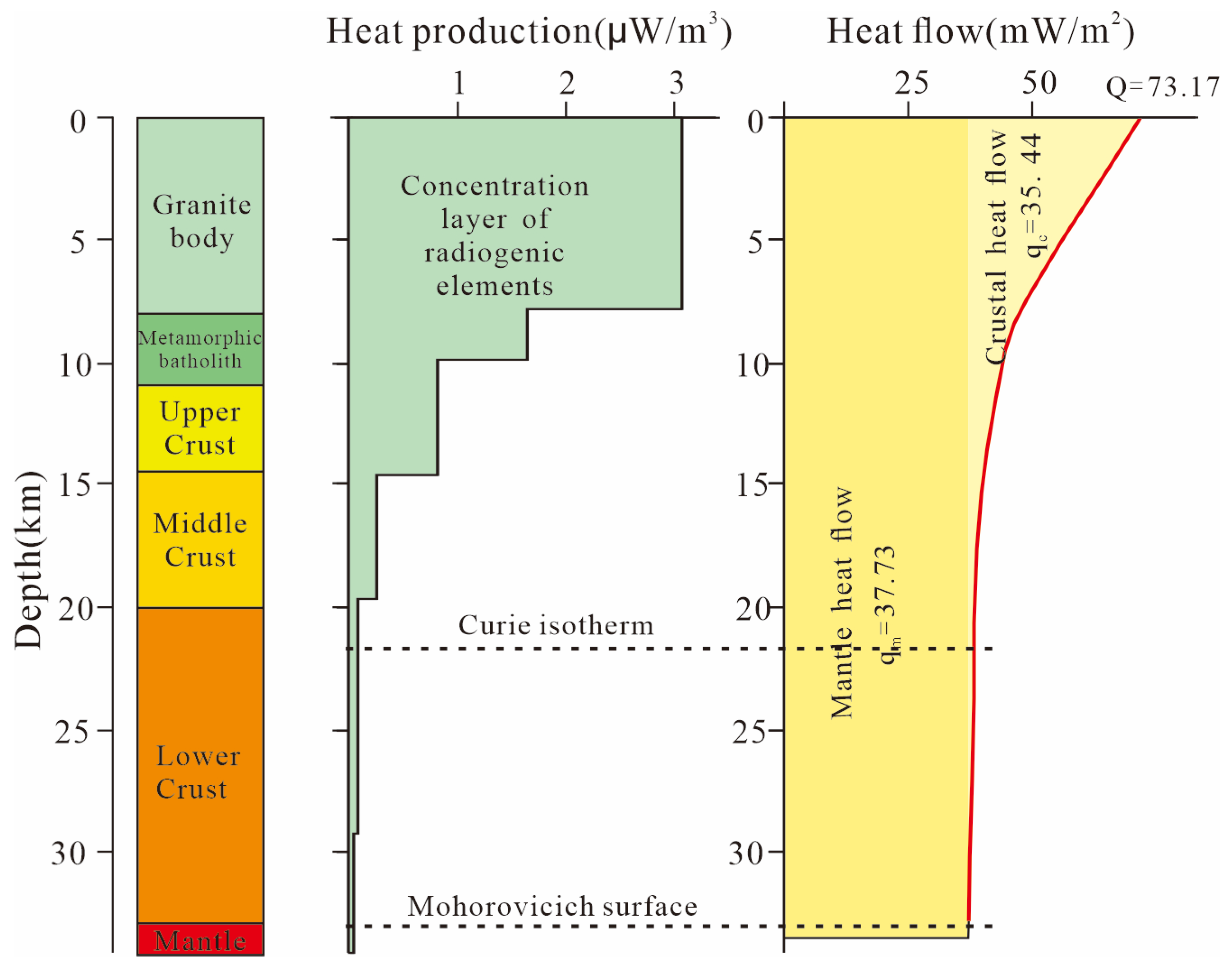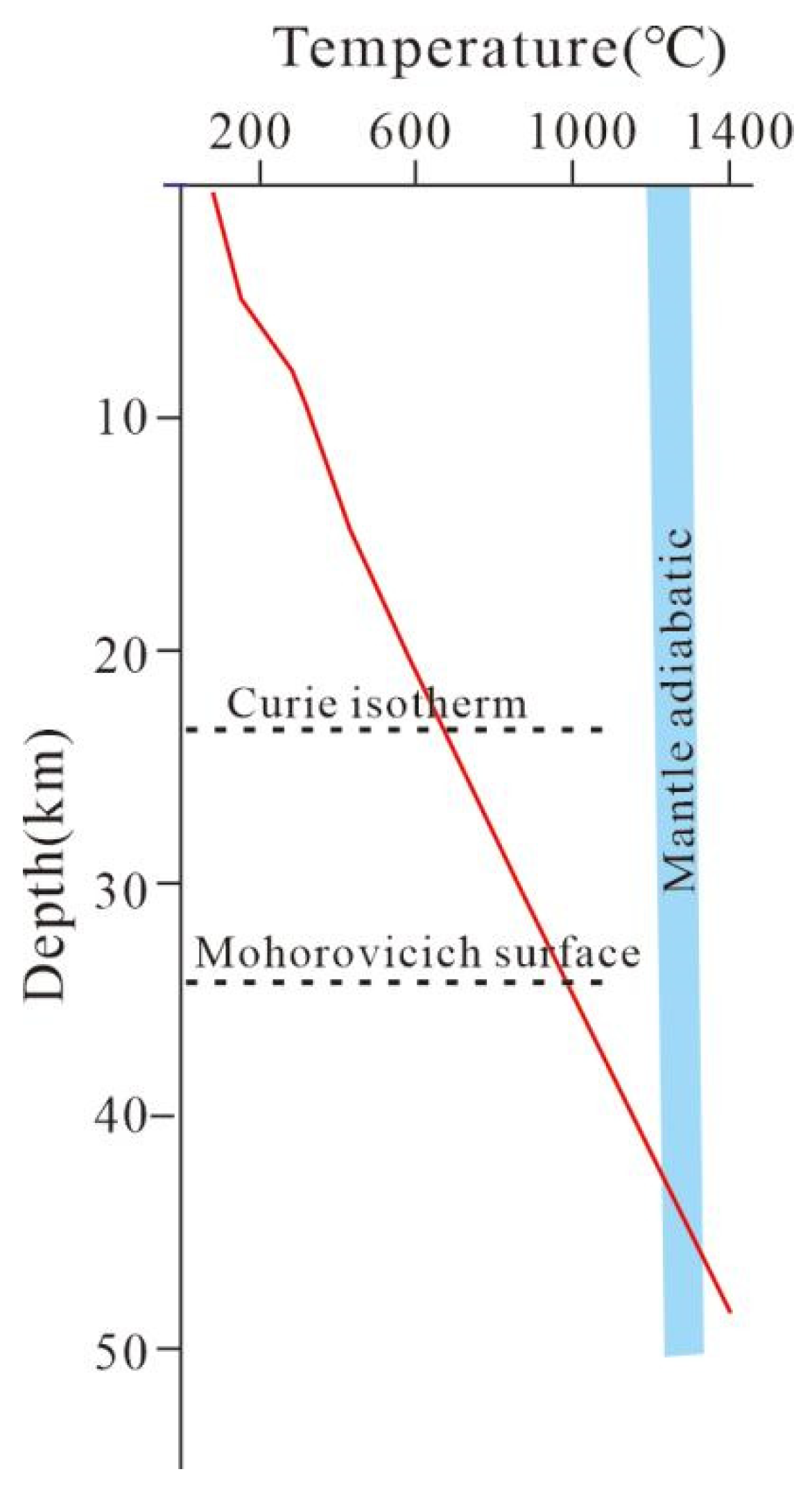Terrestrial Heat Flow and Lithospheric Thermal Structure Characteristics in Nanping City of Hainan
Abstract
:1. Introduction
2. Study Area
3. Materials and Methods
3.1. Sample Collection and Testing
3.2. Borehole Temperature Measurement
3.3. Thermal Conductivity Coefficient Test
3.4. Heat-Generation Rate
3.5. Surface Heat-Flow Calculation
4. Results
4.1. Distribution Characteristics of the Vertical Geothermal Field
4.2. Thermal Conductivity Characteristics
4.3. Heat-Generation-Rate Characteristics
4.4. Heat-Flow Calculation
5. Discussion
5.1. Heat-Flow Composition Analysis
5.2. The Thickness of Thermal Lithosphere
6. Conclusions
- (1)
- The test analysis reveals that the thermal conductivity of the Baocheng rock mass in Nanping exhibits an increasing trend with depth while gradually decreasing with higher degrees of weathering. The thermal conductivity values for lower weathered biotite granites range from 2.29 to 3.75 W/(m·K), with an average value of 2.72 W/(m·K), and that of moderately weathered biotite granites ranges from 1.47 to 3.02 W/(m·K), with an average value of 1.69 W/(m·K).
- (2)
- Borehole temperature measurements indicate that hot water migration in this area is significantly influenced by convection processes. By applying groundwater correction, the surface heat flux is calculated to be 89–99.23 mW/m2, reflecting the good geothermal geological background in this region.
- (3)
- Based on the measured rock mass heat-generation rates and calculations using seismic wave velocity, the distribution pattern of heat flow across different layers within the research area can be determined. The surface heat flux includes both conduction dissipation (73.17 mW/m2) and convective transport by groundwater (15.83–26.06 mW/m2). Groundwater convection contributes approximately 17.8–26.26% to the total heat flow in this area. In the conduction heat, the crustal and mantle heat flows have a division ratio close to 1:1.07. The thermal structure of the lithosphere belongs to the crust and mantle heat-source equilibrium zone.
- (4)
- The thickness of the hot lithosphere is only 42–46 km, and a Moho surface temperature reaches as high as 787 °C. This suggests a strong influence from mantle heating action, along with crustal extension and thinning toward the ocean.
Author Contributions
Funding
Data Availability Statement
Conflicts of Interest
References
- Wang, J.Y.; Huang, S.B. Compilation of heat flow data for continental area of China. Sci. Geol. Sin. 1988, 2, 196–204. [Google Scholar]
- Jiang, G.; Hu, S.; Shi, Y.; Zhang, C.; Wang, Z.T.; Hu, D. Terrestrial heat flow of continental China: Updated dataset and tectonic implications. Tectonophysics 2019, 753, 36–48. [Google Scholar] [CrossRef]
- Davies, J.H. Global map of solid Earth surface heat flow: Global Surface Heat Flow Map. Geochem. Geophys. Geosyst. 2013, 14, 4608–4622. [Google Scholar] [CrossRef]
- Wang, G.L.; Lin, W.J. Main hydro-geothermal systems and their genetic models in China. Acta Geol. Sin. 2020, 94, 1923–1937. [Google Scholar]
- Muffler, L.J.P. Tectonic and Hydrologic Control of the Nature and Distribution of the Second United Nations Symposium on the Development and Use of Geothermal Resources; Government Printing Office: Washington, DC, USA, 1976; pp. 499–507.
- Xiong, L.P.; Wang, J.Y.; Pang, Z.H. Convective and Conductive Heat Flows in Zhangzhou Geothermal Field, Fujian Province, China. ACTA Geophys. Sin. 1990, 33, 702–711. [Google Scholar]
- Roy, R.F.; Blackwell, D.D.; Birch, F. Heat generation of plutonic rocks and continental heat flow provinces. Earth Planet. Sci. Lett. 1968, 5, 1–12. [Google Scholar] [CrossRef]
- Lachenbruch, A.H. Crustal temperature and heat production: Implications of the linear heat-flow relation. J. Geophys. Res. 1970, 75, 3291–3300. [Google Scholar] [CrossRef]
- Furlong, K.P.; Chapman, D.S. Heat Flow, Heat Generation, and the Thermal State of the Lithosphere. Annu. Rev. Earth Planet. Sci. 2013, 41, 385–410. [Google Scholar] [CrossRef]
- Qiu, N.S.; Hu, S.B.; He, L.J. Geothermics in Sedimentary Basins; China University of Petroleum Press: Beijing, China, 2019. [Google Scholar]
- Wang, G.L.; Liu, F.; Lin, W.J.; Zhang, W.; Yuan, R.; Xi, Y.F.; Wei, S.C.; Liao, Y.Z.; Wang, Y.R. The crustal heat production rate and crustal and mantle heat flow distribution in the land areas of China. Chin. J. Geophys. 2023, 66, 5041–5056. [Google Scholar]
- Qiu, N.S.; Tang, B.N.; Zhu, C.Q. Deep thermal background of hot spring distribution in the Chinese continent. Acta Geol. Sin. 2022, 96, 195–207. [Google Scholar]
- Liao, Y.Z.; Zhang, W.; Rong, Y.W.; Liu, F.; Wei, S.C.; Li, L.; Zhao, Z.R.; Li, M. A high geothermal setting in the Linyi geothermal field: Evidence from the lithospheric thermal structure. Energy Explor. Exploit. 2023, 41, 1899–1918. [Google Scholar] [CrossRef]
- Wei, S.C.; Liu, F.; Zhang, W.; Wang, G.L.; Yuan, R.X.; Liao, Y.Z. Research on the characteristics and influencing factors of terrestrial heat flow in Guizhou Province. J. Groundw. Sci. Eng. 2022, 10, 166–183. [Google Scholar]
- Hu, S.B.; He, L.J.; Wang, J.Y. Compilation of heat flow data in the China continental area(3rd edition). Chin. J. Geophys. 2001, 44, 611–626. [Google Scholar]
- Chen, M.X.; Xia, S.G.; Yang, S.Z. Local geothermal anomalies and their formation mechanisms on Leizhou peninsula, South China. Sci. Geol. Sin. 1991, 4, 369–383. [Google Scholar]
- Zhang, Q.; Wu, X.J.; Xie, S.S.; Han, Z.; Zhang, Z. The Application of Comprehensive Geophysical Methods to Exploration of Hot Dry Rock Resources in Lingshui Area of Hainan. Chin. J. Eng. Geophys. 2015, 12, 477–483. [Google Scholar]
- Yuan, X.B.; Fang, N.J.; Dong, H.L. Geochronology, Geochemistry and Tectonic Significance of Gaofeng and Baocheng Granite Batholiths in Hainan Island. Geoscience 2019, 33, 85–97. [Google Scholar]
- Yun, P.; Wu, Y.B.; Xie, S.Z. Origin of rock-forming minerals from some late Yanshanian granite bodies in Hainan island. Geol. Miner. Resour. South China 2004, 4, 1–8. [Google Scholar]
- Liu, Y.H.; Mao, J.W.; Qiu, K.F.; Hu, J.; Wang, L.; Xu, D.M. Extensional Setting of Hainan Island in Mesoproterozoic: Evidence from Granitic Intrusions in the Baoban Group. Acta Geol. Sin. (Engl. Ed.) 2022, 96, 1199–1212. [Google Scholar] [CrossRef]
- Zhang, F.F.; Wang, Y.J.; Chen, X.Y.; Fan, W.M.; Zhang, Y.H.; Zhang, G.W.; Zhang, A.M. Triassic high-strain shear zones in Hainan Island (South China) and their implications on the amalgamation of the Indochina and South China Blocks: Kinematic and 40Ar/39Ar geochronological constraints. Gondwana Res. 2011, 19, 910–925. [Google Scholar]
- Yu, J.H.; O’Reilly, S.Y.; Zhou, M.F.; Griffin, W.L.; Wang, L.J. U-Pb geochronology and Hf–Nd isotopic geochemistry of the Badu Complex, Southeastern China: Implications for the Precambrian crustal evolution and paleogeography of the Cathaysia Block. Precambrian Res. 2012, 222–223, 424–449. [Google Scholar] [CrossRef]
- DZ/T0080-2010; Specifications for Geophysical Logging of Coal. Ministry of Land and Resources of the People’s Republic of China: Beijing, China, 2010.
- He, L.J.; Hu, S.B.; Huang, S.P.; Yang, W.C.; Wang, J.Y.; Yuan, Y.S.; Yang, S.C. Heat flow study at the Chinese Continental Scientific Drilling site: Borehole temperature, thermal conductivity, and radiogenic heat production. J. Geophys. Res. Solid Earth 2008, 113, 113–129. [Google Scholar]
- Wang, J.; Wang, J.A.; Shen, J.Y.; Qiu, N.S. Heat Flow in Tarim Basin. Earth Sci.-J. China Univ. Geosci. 1995, 20, 399–403. [Google Scholar]
- Zhao, Y.X.; Yang, S.Z.; Zhang, W.R.; Lian, X.R.; Ma, L. An experimental study of rock thermal conductivity under different temperature and pressure. Prog. Geophys. 1995, 10, 104–113. [Google Scholar]
- Seipold, U. Temperature dependence of thermal transport properties of crystalline rocks—A general law. Tectonophysics 1998, 291, 161–171. [Google Scholar] [CrossRef]
- Song, J.J.; Wang, G.L.; Xing, L.X.; Lu, C.; Qian, J.Y. Influence of rock thermal conductivity correction on the calculated value of terrestrial heat flow—A case study of Jizhong Depression, Bohai Bay Basin. Geol. Rev. 2023, 69, 1349–1364. [Google Scholar]
- Pribnow, D.; Williams, C.F.; Sass, J.H.; Keating, R. Thermal conductivity of water-saturated rocks from the KTB Pilot Hole at temperatures of 25 to 300°C. Geophys. Res. Lett. 1996, 23, 391–394. [Google Scholar] [CrossRef]
- Vosteen, H.D.; Schellschmidt, R. Influence of temperature on thermal conductivity, thermal capacity and thermal diffusivity for different types of rock. Phys. Chem. Earth Parts A/B/C 2003, 28, 499–509. [Google Scholar] [CrossRef]
- Rybach, L. Radioactive heat production in rocks and its relation to other petrophysical parameters. Pure Appl. Geophys. 1976, 114, 309–317. [Google Scholar] [CrossRef]
- Rybach, L.; Buntebarth, G. The variation of heat generation, density and seismic velocity with rock type in the continental lithosphere. Tectonophysics 1984, 103, 335–344. [Google Scholar] [CrossRef]
- Xin, H.L.; Zhang, H.J.; Kang, M.; He, R.Z.; Gao, L.; Gao, J. High-Resolution Lithospheric Velocity Structure of Continental China by Double-Difference Seismic Travel-Time Tomography. Seismol. Res. Lett. 2019, 90, 229–241. [Google Scholar] [CrossRef]
- Uchida, Y.; Sakura, Y.; Taniguchi, M. Shallow subsurface thermal regimes in major plains in Japan with reference to recent surface warming. Phys. Chem. Earth Parts A/B/C 2003, 28, 457–466. [Google Scholar] [CrossRef]
- Huang, S.; Pollack, H.N.; Shen, P.Y. Temperature trends over the past five centuries reconstructed from borehole temperatures. Nature 2000, 403, 756–758. [Google Scholar] [CrossRef]
- Zhang, J.; Huang, S.P.; Zuo, Y.H.; Zhou, Y.S.; Liu, Z.; Duan, W.T.; Wei, X. Terrestrial heat flow in the baiyinchagan sag, erlian Basin, northern China. Geothermics 2020, 86, 101799. [Google Scholar] [CrossRef]
- Geological Team of Hainan. Hydrogeological Exploration Report of Hot Water Area New Village Baoting, Hainan Island; Guangdong Geological Bureau: Guangzhou, China, 1973. [Google Scholar]
- McLaren, S.; Sandiford, M.; Hand, M.; Neumann, N.; Wyborn, L.; Bastrakova, I. The hot southern continent: Heat flow and heat production in Australian Proterozoic terranes. In Evolution and Dynamics of the Australian Plate; Geological Society of America: Boulder, CO, USA, 2003. [Google Scholar]
- Zhang, L.; Hu, Y.L.; Qin, M.; Duan, Y.; Duan, Y.Z.; Peng, H.C.; Zhao, H. Study on crustal and lithosphere thicknesses of Tengchong volcanic area in Yunnan. Chin. J. Geophys. 2015, 58, 1622–1633. [Google Scholar]
- Fullea, J.; Muller, M.R.; Jones, A.G.; Afonso, J.C. The lithosphere–asthenosphere system beneath Ireland from integrated geophysical–petrological modeling II: 3D thermal and compositional structure. Lithos 2014, 189, 49–64. [Google Scholar] [CrossRef]
- Jaupart, C.; Mareschal, J.C. Heat flow and thermal structure of the lithosphere. In Treatise on Geophysics; Schubert, G., Ed.; Elsevier: New York, NY, USA, 2007; Volume 6, pp. 217–252. [Google Scholar]
- An, M.J.; Shi, Y.L. Review on lithospheric thickness research of the Chinese continent. Earth Sci. Front. 2006, 13, 23–30. [Google Scholar]
- Rudnick, R.L.; McDonough, W.F.; O’Connell, R.J. Thermal structure, thickness and composition of continental lithosphere. Chem. Geol. 1998, 145, 395–411. [Google Scholar] [CrossRef]
- Artemieva, I.M.; Mooney, W.D. Thermal thickness and evolution of Precambrian lithosphere: A global study. J. Geophys. Res. Solid Earth 2001, 106, 16387–16414. [Google Scholar] [CrossRef]
- Chapman, D.S.; Pollack, H.N. Regional geotherms and lithospheric thickness. Geology 1977, 5, 265. [Google Scholar] [CrossRef]
- Xiong, S.Q.; Yang, H.; Ding, Y.Y.; Li, Z.K. Characteristics of Chinese continent curie point isotherm. Chin. J. Geophys. 2016, 59, 643–657. [Google Scholar]
- Tang, X.Y.; Huang, S.P.; Zhang, G.C.; Yang, S.C.; Hu, S.B. Lithospheric thermal structure of the Pearl River Mouth Basin, northern South China Sea. Chin. J. Geophys. 2018, 61, 3749–3759. [Google Scholar]








| Drilling ID | Drilling Depth (m) | Groundwater Level (m) | Sample ID | Lithology | Depth (m) | Heat Conductivity | Heat Generation Rate | |
|---|---|---|---|---|---|---|---|---|
| 1 | NPZK01 | 300 | 3.9 | NPZK01-1 | Medium-weathered biotite monzogranite | 125 | √ | √ |
| 2 | NPZK1-Y10 | Diorite | 197 | √ | - | |||
| 3 | NPZK01-2 | Diorite | 211 | √ | √ | |||
| 4 | NPZK02 | 400 | 3.6 | NPZK02-1 | Medium-weathered biotite monzogranite | 95 | √ | √ |
| 5 | NPZK2-Y10 | Diorite | 203.1 | √ | - | |||
| 6 | NPZK02-2 | Medium-weathered biotite monzogranite | 254 | √ | √ | |||
| 7 | NPZK02-3 | Diorite | 347 | √ | √ | |||
| 8 | NPZK03 | 400 | 1.1 | NPZK03-1 | Medium-weathered biotite monzogranite | 127 | √ | - |
| 9 | NPZK03-2 | Medium-weathered biotite monzogranite | 246 | √ | - | |||
| 10 | NPZK03-3 | Medium-weathered biotite monzogranite | 344 | √ | - | |||
| 11 | NPZK03-Y12 | Diorite | 372.9 | √ | - | |||
| 12 | NPZK03-Y13 | Monzogranite | 392.7 | √ | - | |||
| 13 | NPZK04 | 600 | 4.8 | NPZK04-1 | Biotite monzogranite | 129 | √ | √ |
| 14 | NPZK04-2 | Biotite monzogranite | 315 | √ | √ | |||
| 15 | NPZK04-3 | Biotite monzogranite | 462 | √ | √ | |||
| 16 | NPZK04-4 | Biotite monzogranite | 585 | √ | √ | |||
| 17 | NPZK05 | 700 | 3 | NPZK05-1 | Biotite monzogranite | 114 | √ | √ |
| 18 | NPZK05-2 | Biotite monzogranite | 224.5 | √ | √ | |||
| 19 | NPZK05-3 | Diorite | 300 | √ | √ | |||
| 20 | NPZK05-4 | Biotite monzogranite | 416 | √ | √ | |||
| 21 | NPZK05-5 | Biotite monzogranite | 500 | √ | √ | |||
| 22 | NPZK05-6 | Biotite monzogranite | 605 | √ | √ | |||
| 23 | NPZK05-7 | Biotite monzogranite | 690 | √ | √ | |||
| 24 | NPZK05-Y13 | Diorite | 699.5 | √ | - |
| Porosity | Heat Conductivity | Corrected Heat Conductivity | Density | U | Th | K | Heat Generation Rate | ||
|---|---|---|---|---|---|---|---|---|---|
| (%) | (W/mK) | (W/m) | (g/cm3) | ppm | ppm | % | μW/m3 | ||
| 1 | NPZK01-1 | 3.37 | 1.489 | 1.47 | 2.68 | 4.92 | 16.5 | 3.06 | 2.67 |
| 2 | NPZK01-2 | 1.41 | 1.242 | 1.27 | 2.78 | 1.01 | 2.38 | 2.15 | 0.64 |
| 3 | NPZK1-Y10 | 2.12 | 2.641 | 2.44 | - | - | - | - | - |
| 4 | NPZK02-1 | 2.96 | 1.517 | 1.51 | 2.72 | 4.49 | 13.6 | 3.26 | 2.42 |
| 5 | NPZK02-2 | 2.96 | 1.733 | 1.71 | 2.57 | 5.56 | 14.2 | 3.6 | 2.62 |
| 6 | NPZK02-3 | 2.85 | 1.502 | 1.49 | 2.63 | 1.16 | 2.2 | 2.61 | 0.68 |
| 7 | NPZK2-Y10 | 2.14 | 2.807 | 2.72 | |||||
| 8 | NPZK03-1 | 7.04 | 1.624 | 1.59 | 2.66 | 4.58 | 18.5 | 3.51 | 2.74 |
| 9 | NPZK03-2 | 8.61 | 1.79 | 1.73 | 2.65 | 4.12 | 13.8 | 3.45 | 2.29 |
| 10 | NPZK03-3 | 5.99 | 2.261 | 2.14 | 2.62 | 10.5 | 23 | 2.93 | 4.43 |
| 11 | NPZK03-Y12 | 1.78 | 2.307 | 2.18 | - | - | - | - | - |
| 12 | NPZK03-Y13 | 2.18 | 3.281 | 3.04 | - | - | - | - | - |
| 13 | NPZK04-1 | 2.97 | 3.517 | 3.17 | 2.65 | 5.24 | 22 | 2.97 | 3.09 |
| 14 | NPZK04-2 | 3.35 | 2.738 | 2.52 | 2.62 | 6.34 | 20.6 | 3.07 | 3.24 |
| 15 | NPZK04-3 | 1.85 | 3.605 | 3.26 | 2.59 | 4.33 | 16.5 | 4.3 | 2.55 |
| 16 | NPZK04-4 | 2.97 | 2.669 | 2.44 | 2.64 | 4.6 | 21.1 | 5.78 | 3.11 |
| 17 | NPZK05-1 | 1.86 | 3.135 | 2.93 | 2.67 | 6.6 | 30.6 | 3.23 | 4.07 |
| 18 | NPZK05-2 | 2.89 | 3.215 | 2.99 | 2.55 | 6.26 | 25.2 | 3.52 | 3.48 |
| 19 | NPZK05-3 | 1.82 | 2.983 | 2.79 | 2.73 | 1.6 | 5.85 | 1.59 | 0.98 |
| 20 | NPZK05-4 | 2.23 | 2.947 | 2.76 | 2.56 | 5.16 | 17.6 | 3.36 | 2.71 |
| 21 | NPZK05-5 | 1.87 | 2.65 | 2.49 | 2.69 | 3.39 | 15.5 | 3.22 | 2.24 |
| 22 | NPZK05-6 | 2.22 | 2.423 | 2.29 | 2.65 | 6.29 | 30.9 | 3.69 | 4.02 |
| 23 | NPZK05-7 | 1.86 | 4.071 | 3.75 | 2.59 | 5.44 | 22.2 | 3.55 | 3.13 |
| 24 | NPZK05-Y13 | 2.11 | 1.9 | 1.83 | - | - | - | - | - |
| Depth (km) | Vp | A |
|---|---|---|
| 0 | 4.771 | 30.798 |
| 5 | 5.463 | 4.625 |
| 10 | 5.921 | 1.318 |
| 15 | 6.385 | 0.369 |
| 20 | 6.708 | 0.153 |
| 30 | 7.101 | 0.052 |
| 40 | 7.255 | 0.034 |
| 60 | 7.787 | 0.008 |
| 80 | 7.928 | 0.005 |
| 100 | 7.747 | 0.009 |
| 120 | 7.737 | 0.009 |
| 150 | 7.779 | 0.008 |
| Location | ID | Measuring Section (m) | Temperature Range (°C) | Vz (m/s) | K W/(m·K) | Q (mW/m2) | |
|---|---|---|---|---|---|---|---|
| Nanping | ZK1 | 0–121 | 30.6–83.6 | 9.56 × 10−8 | 2.72 | 89 | |
| ZK5 | 67–634 | 47.86–67.06 | 4.2 × 10−8 | 2.72 | 92.9 | ||
| Qixianling | ZK11 | 19–160 | 34–44.2 | 5.8 × 10−8 | 1.99 | 96.23 | 99.23 |
| 160–464 | 70.5–95.6 | 1.3 × 10−8 | 1.99 | 96.61 | |||
| 464–532 | 95.6–99.3 | 1.99 | 108.27 | ||||
| Heat Flux (mW/m2) | Lithology (km) | Heat Conductivity (W/m·K) | |
|---|---|---|---|
| 73.17 | Baocheng granite body | 0–8 | 2.72 |
| Metamorphic batholith | 8–11 | 2.9 | |
| Upper crust | 11–14 | 2.9 | |
| Middle crust | 14–20 | 2.3 | |
| Lower crust | 20–34 | 2.5 | |
| Mantle | >34 | 2.5 | |
Disclaimer/Publisher’s Note: The statements, opinions and data contained in all publications are solely those of the individual author(s) and contributor(s) and not of MDPI and/or the editor(s). MDPI and/or the editor(s) disclaim responsibility for any injury to people or property resulting from any ideas, methods, instructions or products referred to in the content. |
© 2024 by the authors. Licensee MDPI, Basel, Switzerland. This article is an open access article distributed under the terms and conditions of the Creative Commons Attribution (CC BY) license (https://creativecommons.org/licenses/by/4.0/).
Share and Cite
Yan, X.; Wang, X.; Xue, G.; Yuan, R.; Yang, F. Terrestrial Heat Flow and Lithospheric Thermal Structure Characteristics in Nanping City of Hainan. Energies 2024, 17, 4824. https://doi.org/10.3390/en17194824
Yan X, Wang X, Xue G, Yuan R, Yang F. Terrestrial Heat Flow and Lithospheric Thermal Structure Characteristics in Nanping City of Hainan. Energies. 2024; 17(19):4824. https://doi.org/10.3390/en17194824
Chicago/Turabian StyleYan, Xiaoxue, Xiaolin Wang, Guicheng Xue, Ruoxi Yuan, and Feng Yang. 2024. "Terrestrial Heat Flow and Lithospheric Thermal Structure Characteristics in Nanping City of Hainan" Energies 17, no. 19: 4824. https://doi.org/10.3390/en17194824






